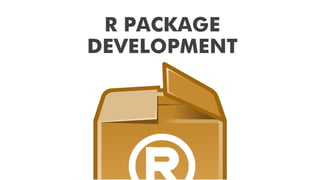Developing in R - the contextual Multi-Armed Bandit edition
- 2. ŌĆó Dominant in statistics research. ŌĆó Interpreted language: No need to compile before run. ŌĆó At its core an Imperative Language. Also supports Functional Programming. And Object Oriented Programming. WHAT IS THE R LANGUAGE?
- 4. Imperative: explore data FP: data analysis OOP: building tools SOŌĆ” WHICH PARADIGM TO USE IN R?
- 5. ALSO, R IS REAL GOOD WITH VECTORS (and matrices) 10 to 100 times faster
- 6. CLASS SYSTEMS ŌĆó S3: minimal ŌĆó S4: very verbose ŌĆó R5: (reference classes) slow ŌĆó C++: fast, not platform independent, needs boilerplate. ŌĆó New: R6 (default at Microsoft)
- 7. ŌĆó New kid on the block ŌĆó Light weight and fast ŌĆó Public and private methods ŌĆó Active bindings ŌĆó Mature inheritance MY PREFERENCE: R6
- 8. ALSO, R6 JUST MAKES ME FEEL RIGHT AT HOMEŌĆ”
- 10. ŌĆó SEMANTIC DEV SKILLS ŌĆó SYNTACTIC DEV SKILLS ŌĆó DOMAIN KNOWLEDGE R DEVELOPMENT IN 3D
- 12. Semantic: What is a Multi-Armed Bandit? ŌĆó Origin: Gambler in casino want to maximize winnings by playing slot machines ŌĆó Balance exploration vs exploitation (also: ŌĆ£learningŌĆØ vs ŌĆ£learningŌĆØ) ŌĆó Objective: Given a set of K distinct arms, each with unknown reward distribution, find the maximum sum of rewards. ŌĆó Example: 3 slot machines (arms) Each 2 pulls explore, what now?
- 13. Translation to health related problem ŌĆó 1. A patient arrives with symptoms, medical history at physician. ŌĆó 2. Physician prescribes treatment A or treatment B. ŌĆó 3. PatientŌĆÖs health responds (e.g., improves, worsens). ŌĆó 4. Depending on results, physician changes opinion on best treatment option for this kind of patient. ŌĆó Goal: prescribe treatments that yield good health outcomes.
- 14. WhatŌĆÖs the challenge for the physician here? ŌĆó Fundamental dilemma ŌĆó Exploit what has been learned ŌĆó Explore to find which behaviors lead to high rewards ŌĆó Need to use context and arm history effectively ŌĆó Different actions are preferred under different contexts ŌĆó Might not see the same context twice
- 15. Solution: use a smart rule: a policy ŌĆó Policy: rule mapping context to action ŌĆó Allows choice of different good actions in different contexts ŌĆó E.g.: ŌĆó If (sex = male) choose action 1 ŌĆó Else if (age > 45) choose action 2 ŌĆó Else choose action 3 ŌĆó Policy Ø£ŗ ŌłČ context Øæź Ōå” (action ØæÄ) + HISTORY ŌĆ” adapt
- 16. LetŌĆÖs formalize, to easier compare, apply .. ŌĆó Use adaptive policy ╬Ā with distribution parameters ╬Ė to make a choice. ŌĆó For t=1,2,ŌĆ”,T: ŌĆó 1. Observe context ØÆÖ ØÆĢ ŌĆó 2. Choose action ØÆé ØÆĢ Ōłł {ؤÅ, ؤÉ, ŌĆ” , Øæ▓} using current ╬Ė of ╬Ā ŌĆó 3. Collect reward Øæ¤ØæĪ(ØæÄ ØæĪ) ŌĆó 4. Using reward Øæ¤ØæĪ(ØæÄ ØæĪ) adapt ╬Ė as suggested by good ╬Ā Goal: finding for choosing actions with high reward ÓĘŹ ØæĪ=1 Øæć Øæ¤ØæĪ ØæÄ ØæĪ
- 18. For example ŌĆ” ŌĆó 1. ŌĆó 2. ŌĆó 3. ŌĆó 4.
- 19. FIRST SKETCH, THEN CODE
- 26. CLEAN CODE Keep It Simple Stupid You ArenŌĆÖt Gonna Need It DonŌĆÖt Repeat Yourself !
- 27. ADDING LI BANDIT: EASY! PSEUDO CODE: YAY!
- 28. ADDING LI BANDIT: EASY! FULLY RANDOMLY OFFERED CHOICES IN REAL LIFE SETTING PEOPLE HAVE MAKE CHOICE WITH KNOWN CONTEXT THE DATA IS USED BY THE BANDIT CHECKS IF POLICY MAKES SAME CHOICE AS PERSON ORIGINALLY MADE IF SO, CAN USE THIS ROW OF INCLUSIVE CONTEXT TO TEST THE POLICY
- 40. VERSION CONTROL / GITHUB your safety net (and makes collaboration easy)
- 41. ALSO HELPS AUTOMATE DEVELOPMENT RELATED PROCESSES
- 42. ZENODO Research Data Repository on releases: auto doi generation
- 43. Commit CONTINUOUS INTEGRATION: DOES YOUR CODEBASE STILL WORK?
- 44. CODECOV.IO INTEGRATION: DO TESTS COVER ALL OF YOUR CODE? CODECOVERAGE
- 46. PARALLEL PROCESSING ON AWS
- 47. THE ART OF PARALLEL PROCESSING 58 cores 120 cores faster Balancing overhead and network with more processing power k3 * d3 * 5 policies * 300 * 10000 58 cores: 132 seconds 120 cores: 390 seconds k3 * d3 * 5 policies * 3000 * 10000 58 cores: 930 seconds 120 cores: 691 seconds
- 49. ŌĆó More documentation, clean result printouts ŌĆó More paper writing (!) ŌĆó Implement famous papers, show same results? ŌĆó Refactor again: to focus less on optimization, more on readability, particularly SyntheticBandit (althoughŌĆ”) WHAT IS NEXT?
- 50. R BEGINNERS R in Action- Robert Kabacoff - R in Action MORE ADVANCED R packages - Hadley Wickham Advanced R - Hadley Wickham CLEAN CODE Code Complete - Steve McConnell Clean Code - Robert C. Martin ALSO INTERESTING R Inferno - Patrick Burns LITERATURE


















































